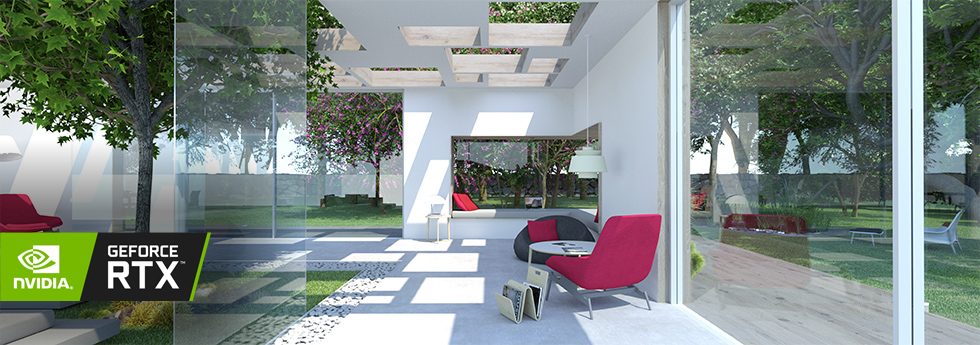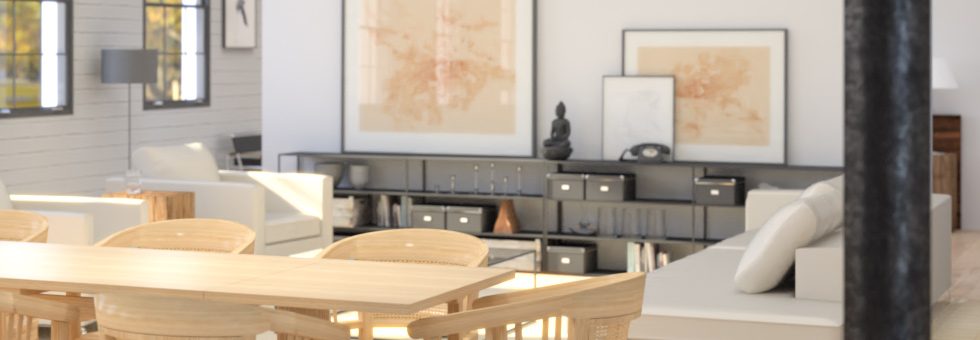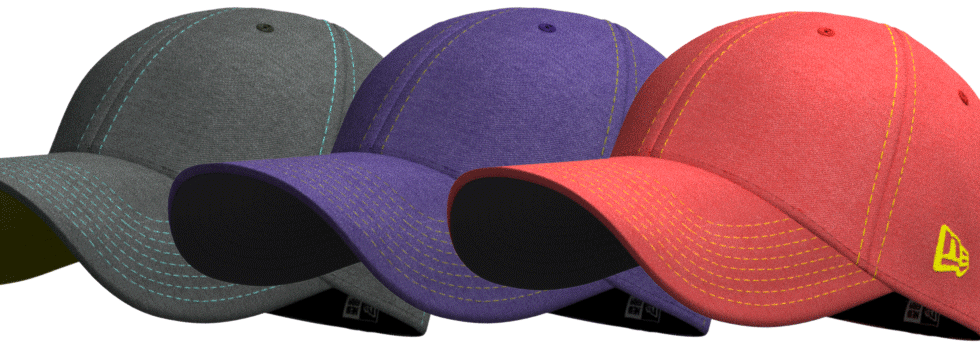
NVIDIA RTX technology was announced late last year and has gathered a lot of coverage in the press. Many software vendors have been scrambling to implement support for it since then and there has been a lot of speculation about what is possible with RTX. Now that Iray RTX is finally about to be part of RealityServer we can talk about what RTX means for our customers and where it will be most beneficial for you.
Paul Arden has worked in the Computer Graphics industry for over 20 years, co-founding the architectural visualisation practice Luminova out of university before moving to mental images and NVIDIA to manage the Cloud-based rendering solution, RealityServer, now managed by migenius where Paul serves as CEO.

Our first update for RealityServer 5.2 is here. It includes an Iray version bump and some nice convenience features. The most significant feature however is support for queuing renders with Iray Server. This will be of interest to those building internal rendering automation tools with RealityServer.
Paul Arden has worked in the Computer Graphics industry for over 20 years, co-founding the architectural visualisation practice Luminova out of university before moving to mental images and NVIDIA to manage the Cloud-based rendering solution, RealityServer, now managed by migenius where Paul serves as CEO.

RealityServer 5.2 is here and adds some great functionality. Hugely expanded glTF 2.0 importer support, wireframe rendering, lightmap rendering, section plane capping, MDL 1.4 support, UDIM support and many more features have been added along with many fixes and smaller enhancements based on extensive customer feedback. In this post we will run through some of the most interesting functionality and how it can help you build your applications.
Paul Arden has worked in the Computer Graphics industry for over 20 years, co-founding the architectural visualisation practice Luminova out of university before moving to mental images and NVIDIA to manage the Cloud-based rendering solution, RealityServer, now managed by migenius where Paul serves as CEO.

In our last post we explored using the RealityServer compositing system to produce imagery for product configurators at scale. Check out that article first if you haven’t already as it contains a great introduction to how the system works. In this follow up post we will explore the possibilities of using the same system to modify the lighting in a scene without having to re-render, allowing us to build a lighting configurator.
Paul Arden has worked in the Computer Graphics industry for over 20 years, co-founding the architectural visualisation practice Luminova out of university before moving to mental images and NVIDIA to manage the Cloud-based rendering solution, RealityServer, now managed by migenius where Paul serves as CEO.

RealityServer 5.1 introduced a new way to generate images of configurations of your scenes without the need to re-render them from scratch. We call this Compositing even though it’s actually very different to traditional compositing techniques. In this article we will dive into the detail of how to use the new system to render without rendering and speed up your configurator.
Paul Arden has worked in the Computer Graphics industry for over 20 years, co-founding the architectural visualisation practice Luminova out of university before moving to mental images and NVIDIA to manage the Cloud-based rendering solution, RealityServer, now managed by migenius where Paul serves as CEO.

RealityServer 5.1 Update 251 has just been released. It’s mainly a bugfix release but adds a few nice extras that several customers have asked about, including a PBR MDL material, Iray Viewer loader and commands for manipulating measured BSDF data.
Paul Arden has worked in the Computer Graphics industry for over 20 years, co-founding the architectural visualisation practice Luminova out of university before moving to mental images and NVIDIA to manage the Cloud-based rendering solution, RealityServer, now managed by migenius where Paul serves as CEO.

RealityServer 5.1 Update 227 has just been released and it has some great new features. A new Iray version with improvements to the AI Denoiser, an easy to use compositing system and a bunch of new convenience commands. This post gives an overview of the new functionality, however the compositing features are so significant that we are currently writing a dedicated article for that feature which will be out soon.
Paul Arden has worked in the Computer Graphics industry for over 20 years, co-founding the architectural visualisation practice Luminova out of university before moving to mental images and NVIDIA to manage the Cloud-based rendering solution, RealityServer, now managed by migenius where Paul serves as CEO.

We recently released RealityServer 4.4 build 1527.93. This update included Iray 2016.2 and some interesting new features. While still an incremental update, the big item many of our customers have been asking for is finally here, NVIDIA Pascal architecture support. So your Tesla P100, Quadro P6000, Quadro P5000, GeForce GTX TITAN X, GeForce GTX 1080, 1070 and other Pascal cards will now work with RealityServer. Keep reading for some more details of the new features in update 93 of RealityServer.
Paul Arden has worked in the Computer Graphics industry for over 20 years, co-founding the architectural visualisation practice Luminova out of university before moving to mental images and NVIDIA to manage the Cloud-based rendering solution, RealityServer, now managed by migenius where Paul serves as CEO.

RealityServer 4.4 build 1527.46 has just been released adding Iray 2016.1.1 which includes support for rendering stereo, spherical VR imagery suitable for viewing with devices such as the Oculus Rift, HTC Vive, Samsung GearVR, OSVR and Google Cardboard viewers. There are also numerous small additions and bug fixes and some other new features such as spectral rendering, however VR rendering is the headline item. In this article we will show you how to do simple VR rendering with RealityServer.
Paul Arden has worked in the Computer Graphics industry for over 20 years, co-founding the architectural visualisation practice Luminova out of university before moving to mental images and NVIDIA to manage the Cloud-based rendering solution, RealityServer, now managed by migenius where Paul serves as CEO.

We have just released RealityServer 4.4 which includes the new NVIDIA Iray 2016.0. We will periodically release updated versions as new improvements and Iray updates become available. We’ll cover some of the highlights of this release here but users are strongly encouraged to read both the RealityServer release notes (relnotes.txt) and the Iray releases notes (neurayrelnotes.pdf) provided with the release. Let’s take a look at those new features, some of which many of our users have been asking about for some time.
Paul Arden has worked in the Computer Graphics industry for over 20 years, co-founding the architectural visualisation practice Luminova out of university before moving to mental images and NVIDIA to manage the Cloud-based rendering solution, RealityServer, now managed by migenius where Paul serves as CEO.

Trove is democratizing the design of jewelry and RealityServer is providing imagery to make it happen. Trove is an online platform for discovering, sharing and customizing 3D printed jewelry designs. Their website (www.troveup.com) enables clients to design, visualize and create beautiful pieces of jewelry from their smartphone or tablet without the need for any special tools or training and, importantly, encourages them both to share and to be inspired by the designs of others in the Trove community. All this is enabled by the innovative application of new technologies throughout the creation process.
Ian Frew has worked in the computer industry for over 25 years, coding early CAD/CAM systems for Computervision, implementing business systems for Fortune 500 companies and commercialising early cloud offerings, before joining migenius to lead activities in EMEA.

KAN Design & Brand Management (www.kandesign.com) is a leading crossmedia branding and design agency. Based in the heart of Europe, KAN has been at the forefront of the branding business for almost 30 years and recently opened offices in New York to serve its increasingly global clientele. Read More
Ian Frew has worked in the computer industry for over 25 years, coding early CAD/CAM systems for Computervision, implementing business systems for Fortune 500 companies and commercialising early cloud offerings, before joining migenius to lead activities in EMEA.

We have just released RealityServer 4.3 which includes the new NVIDIA Iray 2015. There are some great new features included and we will be adding several more to incremental releases in the future based on new additions to Iray. We’ll cover some of the highlights for you here, there are also a lot of smaller additions so we encourage users to take a look through the release notes for both RealityServer and Iray. Here is a taste of what’s new, starting with something we have been waiting a very long time for and are very glad to say has been included in this release. Read More
Paul Arden has worked in the Computer Graphics industry for over 20 years, co-founding the architectural visualisation practice Luminova out of university before moving to mental images and NVIDIA to manage the Cloud-based rendering solution, RealityServer, now managed by migenius where Paul serves as CEO.

As any retailer or product marketer knows, it is almost impossible to sell a product without a photograph. The prospective purchaser gains reassurance and essential detail from these images regarding useability, suitability, attractiveness, size, functionality, etc., that cannot be communicated by words alone. And these images have been proven to do the job significantly better if they are of high resolution and show the product in context, enabling the buyer to see exactly how their specific product will look in their own environment. Read More
Chris has over 20 years of direct experience and deep knowledge of 3D project management systems and high speed physical based rendering technologies. As former CEO and co-founder of Luminova, a specialist 3D visualisation and application development group, some 3,000 projects were successfully delivered to many of the world’s largest companies, over a 13 year period. Since 2011 Chris has been a partner and co-founder of migenius, the home of the cloud based RealityServer solution platform.

It’s MDL Monday again and this week I am going to show you how to put together a simple material for simulating diamonds, including dispersion based on an Abbe number. Now, I’m not a 3D artist by any means, but MDL allows me to create a material like this based on the real physical properties of diamonds rather than trying to tune abstract parameters. This material is very simple but very useful if you need to simulate jewellery. You can build on it easily to simulate other gemstones, glasses and similar substances without much effort. Today I’m just going to start with a basic, colourless diamond and cover some concepts which are important for creating physical materials.
Paul Arden has worked in the Computer Graphics industry for over 20 years, co-founding the architectural visualisation practice Luminova out of university before moving to mental images and NVIDIA to manage the Cloud-based rendering solution, RealityServer, now managed by migenius where Paul serves as CEO.

NVIDIA Iray 2015 will introduce some great new features, including the ability to write your own procedural functions for use in materials. This is fantastic for creating resolution independent effects which can cover large areas without noticeable tiling artifacts (unless you want them of course). Iray is built into our RealityServer product so I love to test out its latest features. To put procedural functions through their paces I decided to try to emulate something procedural from my childhood, the now famous 10 PRINT program. This little one liner, originally designed to demonstrate the capabilities of the Commodore 64 prints a maze by randomly alternating between two diagonal characters. Iray uses the NVIDIA Material Definition Language (MDL) both to define materials as well as custom functions, if you haven’t tried it out this little tutorial is a great way to get started.
Paul Arden has worked in the Computer Graphics industry for over 20 years, co-founding the architectural visualisation practice Luminova out of university before moving to mental images and NVIDIA to manage the Cloud-based rendering solution, RealityServer, now managed by migenius where Paul serves as CEO.